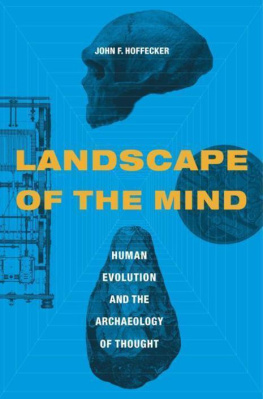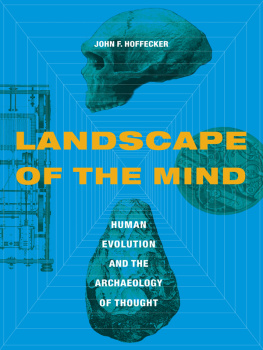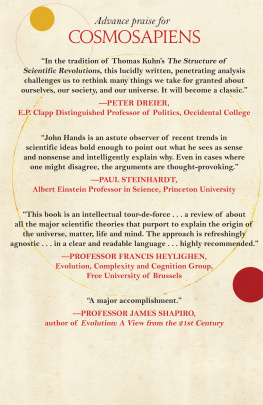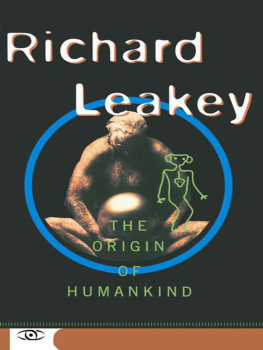Contents
Guide
Pagebreaks of the print version
MODERN HUMANS
Modern Humans
THEIR AFRICAN ORIGIN AND GLOBAL DISPERSAL

John F. Hoffecker

Columbia University Press
New York
Columbia University Press
Publishers Since 1893
New York Chichester, West Sussex
cup.columbia.edu
Copyright 2017 John F. Hoffecker
All rights reserved
E-ISBN 978-0-231-54374-3
Library of Congress Cataloging-in-Publication Data
Names: Hoffecker, John F., author.
Title: Modern humans : their African origin and global dispersal / John F. Hoffecker.
Description: New York : Columbia University Press, 2017. | Includes bibliographical references and index.
Identifiers: LCCN 2017025425 (print) | LCCN 2016058573 (ebook) | ISBN 9780231160766 (cloth : alk. paper)
Subjects: LCSH: Human beingsOrigin. | Human beingsMigrations. | Human evolution.
Classification: LCC GN281 .H625 2017 (ebook) | LCC GN281 (print) | DDC 599.93/8dc23
LC record available at https://lccn.loc.gov/2017025425
A Columbia University Press E-book.
CUP would be pleased to hear about your reading experience with this e-book at .
Cover design: Milenda Nan Ok Lee
Cover photo: Martin Schoeller / Art + Commerce Image Archive
In Memoriam
KARL W. BUTZER
(19342016)
CONTENTS
Why may we not say that all Automata (Engines that move themselves by springs and wheeles as doth a watch) have an artificiall life?
Thomas Hobbes (1651)
As Charles Darwin observed in 1871, humans are the most dominant animal that has ever appeared on the earth. Their dominance is measured not by physical size or by numbers or total biomass, although the latter two are impressive. Rather, it is measured by their control of the environment.
To begin with, humans have occupied virtually every terrestrial habitat on Earth, which is remarkable for a single species, especially because it was largely accomplished more than 45,000 years ago, when the direct ancestors of living humans first spread across much of the land surface of the planet. Moreover, by manipulating both its biotic and its abiotic components, humans have radically altered the environment to suit their own needs, exponentially increasing their numbers and suppressing or eliminating other life-forms along the way. Here, too, the process began more than 45,000 years ago, long before the emergence of the earliest civilizations.
Humans control of the environment is based on their ability to manipulate objects and materials in complex ways (that is, to make and use complex artifacts). There is nothing remarkable about the capacity to move or modify physical objects and materials, which is widespread in the animal kingdom, but the level of complexity that underlies human technology is unique. Humans can translate a large body of information stored in the brain into a hierarchically organized artifact such as a set of winter clothing or a sailboat. The artifacts of humans may be designed with an autonomous functiona machine , such as a self-acting rabbit snare or a mechanical clockthat Thomas Hobbes described as artificiall life in 1651.
Evolution: The Major Transitions
The evolution of life on Earth, from its beginning more than 3 billion years ago, provides a perspective on the unique ability of humans to translate information from the brain to structureincluding functioning structurein the form of a complex artifact. As John Maynard Smith and Ers Szathmry observed, the evolution of living systems has been characterized by a series of major transitions. Each reflects a fundamental change in how information is stored, transmitted, and translated . An example is the transition from single-celled to multicellular organisms, which took place more than 1 billion years ago. And each transition represents a quantum jump to a new level of complexity with emergent properties .
Maynard Smith and Szathmry included humans on their list of major transitions in evolution.

FIGURE 1.1The translation of information into structure: ( a ) the translation of genetic information into a functioning organism in the form of a cat; ( b ) the translation of information stored in the human brain into functioning structure in the form of a two-state machine, or automaton (rabbit snare made by the Tanaina [see box figure 4.3]). ([ b ] From Cornelius Osgood, The Ethnography of the Tanaina [New Haven, Conn.: Yale University Press, 1937], 93, fig. 20. Courtesy of Yale University Publications in Anthropology)
The capacity of humans to translate neuronal information into material structure, including functioning structure, represents a major transition in evolution, and it parallels the translation of genetic information into functioning structure (living organisms). Some suggest that the earliest life-forms were both information and structure or, more specifically, RNA acting as an enzyme (or a ribozyme).
Evolution as Computation
One way to look at evolution is as a form of computation . The evolutionary process contains all the basic elements of a computation: input (random changes and/or recombination of genetic information that is translated into organisms), operations or defining functions (natural selection of organisms), and output (changes in the genetic information and the organisms). The immense variety is a consequence of the many hierarchical levels of living systems.
The computations of the evolutionary process take place on several levels, however, and with more than one form of information. ).
Long ago, prokaryotes evolved a form of computation on the level of the organism that allows an individual to respond to unpredictable variations in its environment. Proteins in the cell wall of a prokaryote transmit chemical signalsa simple non-genetic form of informationabout the presence of potential food sources or threats, and the organism responds by moving toward or away from whatever triggered the signal. Unlike the computations of an evolving lineage, the process is a deterministic one with a predictable outcome.
The metazoa evolved a much more complex form of computation on the level of the organism, with a new type of information generated at the cellular level. Specialized eukaryotic nerve cells, or neurons , transmit and store information in the electrochemically charged structures ( synapses ) that connect one neuron with others. And, like the mutation and recombination of genetic information, metazoan development includes a randomizing process that renders computation with neuronal information nondeterministic and potentially creative ().

FIGURE 1.2Evolutionary computation on two levels: ( a ) computation on the level of the evolving lineage; ( b ) computation performed by the metazoan brain on the level of the individual organism. Humans have developed a new level of evolutionary computation in the form of automata. (Redrawn from John E. Mayfield, The Engine of Complexity: Evolution as Computation [New York: Columbia University Press, 2013], 143, fig. 5.3 [ a ], 253, fig. 10.1 [ b ])











